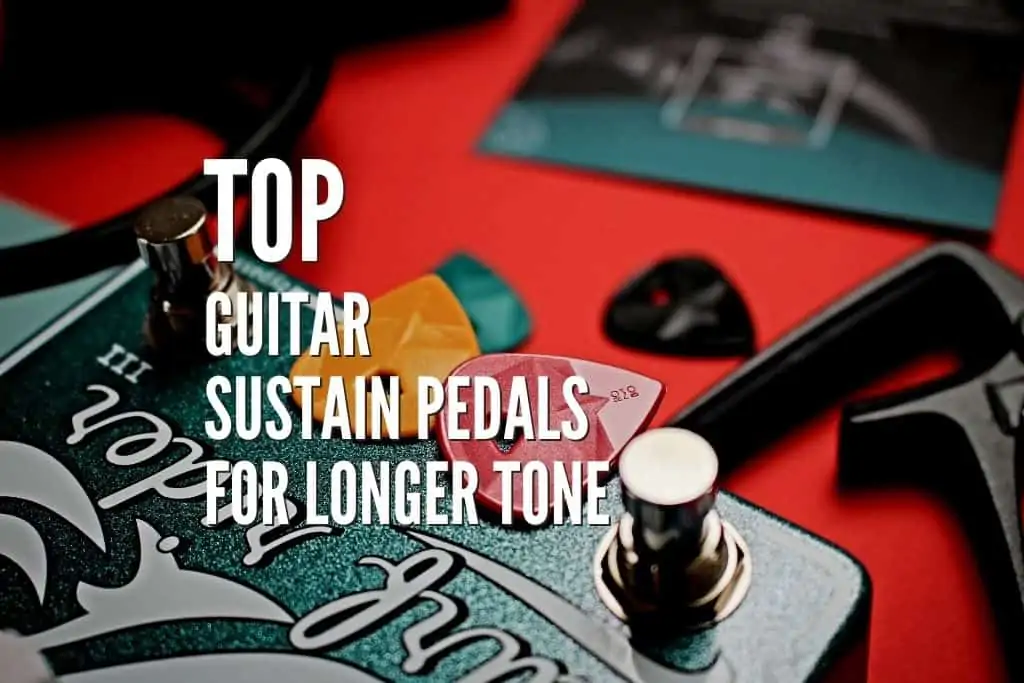If you play electric guitar, you probably know what sustain is. Now, for all of you wondering if there is a way to prolong the sustain on your guitar, the answer is yes. There are a couple of sustain pedals that will increase the length of your guitar’s output, and allow you to try out different techniques.
Now, it is important to mention that sustain pedals aren’t among the essential equipment for electric guitar, and they mostly depend on the music genre you’re playing. It is a lot more common to see a pedalboard with a tuner, delay, and wah.
But if you are interested in owning something that will improve the sustain on your instrument, here are the top ten guitar sustain pedals that you might want to check out.
Behringer CS400 Compressor/Sustainer
- Compress/Sustainer Pedal with Level
- Sustain Controls
- Attack
- Tone
- Made in Germany
- Sustain and Compressor pedal for electric guitar
- Four potentiometers – Level, Tone, Attack, Sustain
- LED indicators to show that the pedal is on
- Works on 9V battery or standard power supply
- True Bypass
- 11.7 Ounces (332 grams)
- 2.8 x 2.1 x 4.8 inches (7.1 x 5.3 x 12.2 centimeters)
Behringer designed this pedal as both compressor and sustain. What you’ll see soon is that there aren’t many sustain pedals you can find, and most are combined with a compressor. CS400 is probably the most popular model you can find, and you won’t have any trouble finding it in your local store.
Furthermore, if you are looking for something that will increase the sustain on your guitar, but without spending a fortune, this might be the right choice. The CS400 pedal is around $25, which is incredible since pedal prices can be significantly higher.

It is probably the main reason for the popularity of this pedal, and it will do a great job once you plug it in. There are four main potentiometers on the device – level, tone, attack, and sustain.
The level potentiometer is for the output signal dB. The tone will adjust the “shade” of the signal, and the attack is for the amount of time before the signal is compressed. Finally, the last knob is sustain, which will increase the length of your tone.
So, if you are looking for a great sustain pedal on a budget, Behringer is the way to go.
Boss CS-3 Compressor/Sustainer
- Analog pedal
- Designed by Boss
- Same design as other Boss pedals
- High-quality sound
- Potentiometers are – Level, Tone, Attack, Sustain
- Red LED when the pedal is on
- Works on 9V battery or power supply
- Buffered Bypass
- 14.9 ounces (422 grams)
- 4 x 3 x 6 inches (10.2 x 7.6 x 15.2 centimeters)
Boss has been around for years, and they proved time and again that they are one of the leaders in the business. Everyone knows about their pedals, and no one can doubt the quality. As you can expect, Boss’ CS-3 is an excellent pedal and it will undoubtedly satisfy your needs.
If you didn’t know, CS-3 is a third compressor/sustain pedal from Boss. The first one, CS-1, was available in 1978. CS-2 came in the eighties. And the current model has been around since 1986.

CS-3 is a great pedal, and anyone can use it. It offers a simple (yet effective) Boss design, and it is rather popular among the musicians going on tours. The reason for this is that you get a 5-year warranty for the pedal.
However, the price is a bit higher compared to the Behringer, and you will need to pay almost four times more if you want to get your hands on this model.
JOYO JF-10 Dynamic Compressor/Sustain Pedal
- Guitar Effect Pedal
- Dynamic Compressor
- Profession Guitar AMP and Effect Pedal
- CE and RoSH Certify
- Combination of low-noise compressor and sustain
- There are three potentiometers – Sustain, Attack, and Level
- Red LED when the pedal is on
- Works on 9V battery or power supply
- True Bypass
- 10.2 ounces (289.2 grams)
- 4.7 x 2.5 x 1.5 inches (11.9 x 6.35 x 3.81 centimeters)
- Compact design
- Affordable and easy to use
The next item on the list is JOYO JF-10 Dyna Compressor. The pedal is designed by Harley Benton, and it is quite affordable. It is perfect for everyone looking to get a great pedal without spending a fortune on it.
There are only three potentiometers on the device, and they are sustain, attack, and level. The main difference between the Behringer and Harley Benton pedal is in the tone knob which might be an issue for some musicians.
However, the main quality is sound. Even though the brand is not as popular as Behringer, the sound might be even better. The reason why I compare it to CS400 is due to the fact that the price is quite similar.

If you like the sound of JOYO JF-10, you will need to spend around $35 for it. This means that it’s perfect for anyone looking to enrich their pedalboard and add a new effect pedal.
DeadBeat Sound Distortion/Sustain Pedal
- Like the legendary Big Muff Pi of the '70s this Distortion/Sustainer Pedal...
- Singing sustain with attitude, Crushing distortion, Adjustable tone and...
- Sleek black minimalist design
- Current Draw of 200 mA
- Combination of distortion and sustain pedal
- Beautiful design with black casing
- Metal case
- Three potentiometers – Volume, Sustain, Tone
- LED lights when the pedal is on
- Works on 9V battery or power supply
- True Bypass
- 1.05 lbs (476.3 grams)
- 4.2 x 2.3 x 2.0 inches (10.67 x 5.84 x 5.08 centimeters)
If you are looking for a modern sustain pedal, you’re in the right place. Unlike previous examples, here, sustain is combined with distortion. For all of you enjoying simple things, the DeadBeat pedal comes in a beautiful package that can be used for storing the pedal once you have finished playing.
As you can see, the pedal is a bit larger compared to others, which might be useful if you are carefully designing your pedalboard. The pedal is easy to use, and it is perfect for anyone looking for a distortion pedal as well.

There are three potentiometers – volume, sustain, and tone. Even though there are only three knobs, this doesn’t mean that you won’t be able to tailor your tone to your needs. The pedal is easy to use, and you’ll have a lot of fun if you opt for this model.
The price for this beauty is not as cheap as some of the entries on the list, but it is still more affordable than the Boss pedal. You can get it for under $50, and it seems like a decent price for such a great piece of equipment.
Electro-Harmonix Nano Big Muff Distortion & Sustain Pedal
No products found.
- Distortion and sustain pedal
- Big Muff Pi circuit in “nano” size
- Metal case
- Three potentiometers – Volume, Sustain, Tone
- Red LED when the pedal is on
- Works on 9V battery or power supply
- True Bypass
- 1.05 lbs (476.3 grams)
- 2.8 x 3.5 x 5.8 inches (7.11 x 8.89 x 14.73 centimeters)
The next pedal is coming from Electro-Harmonix and it is a combination of distortion, fuzz, and sustain. It falls into the mid to high price range, and you can get it for around $90. The main quality of Big Muff is the iconic fuzz that you probably heard many times.
Naturally, the pedal is perfect for any player who enjoys fuzz and wants to improve their sustain as well.

The Nano Big Muff is almost the same as their well-known Big Muff pedal, but it’s smaller. Of course, the main idea is to save space on your pedalboard without sacrificing the sound.
The smaller version of Big Muff has three potentiometers, for volume, sustain, and tone. It’s easy to use, and it is undoubtedly among the best pedals you can find. It is great for touring musicians, as well as anyone else looking for that famous fuzz.
With such quality, it is more than obvious that the price will be a bit higher, but considering the sound quality, it seems quite reasonable.
Pigtronix Philosopher’s Tone – Guitar Compression/Sustain Pedal
- Noiseless clean sustain Blend control for parallel compression Treble EQ...
- Turn lead to gold with the Pigtronix Philosopher’s Tone Micro
- Famous for its noiseless clean sustain, the Philosopher’s Tone stands out...
- The Philosopher’s Tone Micro packs all of the optical compression and...
- Analog compression and sustain pedal
- Metal case
- Four potentiometers – Sustain, Blend, Treble, Volume
- LED when the pedal is on
- Works on 9V battery or power supply
- True Bypass
- 1.05 lbs (476.3 grams)
- 4.2 x 2.3 x 2.0 inches (10.67 x 5.84 x 5.08 centimeters)
Whether you are a fan of Harry Potter books, or you’re looking for a great sustain pedal, Philosopher’s Tone might be a perfect thing for you. The main quality of this pedal hides in the ability to provide sustain even when you’re playing on a clean channel.
There are four potentiometers you can use to further shape your tone and they are sustain, blend, treble, and volume. The blend is used to control the mix between dry and wet signal, treble is for high frequencies, and volume and sustain are obvious controls.
The pedal falls into the pro category, and you can easily find the tone you like.

However, the main downside of the pedal is its price since it is the most expensive pedal on the list (so far). If you want to get your hands on this beauty, you should be prepared to pay almost $120!
But even if you consider the price, the pedal is more than worth it. It offers noiseless sustain and EQ that will allow you to shape your tone with ease. It is also one of the rare pedals that work incredibly on the clean channel.
Wampler Ego Compressor/Sustain Pedal
- Brings a new level of of control to what is expected and needed by today's...
- Designed to ensure playing dynamics could be retained without coloring the...
- Allows your original signal to be blended in so you can get all the...
- With this pedal you can have full country squash or open studio level...
- The pedal is handbuilt in the U.S.
- Low noise with high-quality sound
- High-grade circuitry
- Metal case
- Five potentiometers – Sustain, Tone, Attack, Volume, and Blend
- LED when the pedal is on
- Works on 9V battery or power supply
- True Bypass
- 1.3 lbs (589.67 grams)
- 6.0 x 2.0 x 3.0 inches (15.24 x 5.08 x 7.62 centimeters)
If you are looking for a premium quality (and premium price) you’re in the right place. The Wampler Ego is a great compressor pedal, but it comes at a cost. Probably the first thing I should tell you is that this pedal is almost $200.
Now, this is a big “no” for many players, since they easily find cheaper pedals that will work almost the same. But if you want a hand-built pedal, directly from the U.S., and if you don’t mind paying a bit more, you’ll love the Wampler Ego.

Of course, the location and design of the pedal aren’t the only reasons for its price, and there is no doubt that it is among the best sustain pedals you can find. There are five potentiometers on it, which will ensure that you can easily create a tone perfect for you and your playstyle.
With five knobs, you’ll have everything you need to create a unique sound for your guitar. And while it is one of the best pedals you can find, the price is something you’ll need to consider as well. If you don’t mind paying more for high-quality equipment, then the Wampler Ego might be a perfect pedal for you.
MXR Dyna Comp Effects Pedal
- In-line compressor “evens out” the signal to your amplifier
- Useful for increased sustain with stable dynamics
- Nashville studio standard
- Power: Dunlop ECB003 AC Adapter or Single 9 volt battery
- Compressor and sustain pedal
- Two potentiometers – Output and Sensitivity
- Works on 9V Battery or power supply
- LED when the pedal is on
- Metal case
- 1.15 pounds (521.63 grams)
- 5.8 x 4.5 x 2.8 inches (14.73 x 11.43 x 7.12 centimeters)
MXR has been around for quite a while, and over the years, they gained armies of followers. You can easily find an MXR pedal for anything you need. Naturally, there is a compressor pedal as well.
Since we are talking about a company that’s so huge, there is no doubt that you will get great quality and incredible tone.

The price of the Dyna Comp falls into the mid-premium range, and it is a bit over $100. While it is not the cheapest model on the list, you should consider what you’ll be getting for the price. Furthermore, you can use it on both clean and drive channels, and it will still sound perfect.
Finally, the Dyna Comp is easy to use since there are only two knobs, and they will allow you to determine the volume on the output and at what volume the pedal will engage.
With MXR, you know what to expect, and this pedal is an essential part of many pedalboards across the globe. Even though the pedal is a bit pricey, it is worth it since you will be getting one of the best compressor pedals available on the market.
Fender The Bends Compressor
- Dual internal audio paths for low noise
- High-current symmetrical control path for fast response time
- Led backlit knobs
- Fender amp Jewel LED
- Compressor and sustain pedal
- Dual audio paths for low noise
- Fast response time
- LED lit potentiometers
- Fender amp Jewel LED
- Magnetically latched hinged door for 9V battery
- It can also work on the power supply
- Four potentiometers – Drive, Recovery, Blend, and Level
- 1 lbs (453.59 grams)
- 5.45 x 4.85 x 3.25 inches (13.84 x 12.32 x 8.26 centimeters)
Fender has been on the top of the food chain for quite a while, and recently, they started designing pedals as well. There are so many different models you can try out, and here, I will focus on Fender’s The Bends.
It is a compressor pedal that works like a charm. If you are a fan of Fender sound, this might be a perfect choice for you. Needless to say, the pedal works best if you own a Fender guitar (and amplifier). But this doesn’t mean that it will sound bad paired with other brands.

With four potentiometers, you will easily find the tone you like. The design of the pedal is similar to other models from the series, and it looks great. The metal case will ensure that nothing happens to your equipment, and if you get bored with LED lights, you can simply turn them off.
When it comes to the price, it is in the higher range since The Bends is around $150. While it might seem too much, you will get an incredible compressor that works like a charm combined with Fender guitars.
Gamechanger Plus Pedal Sustain Pedal
- PLUS PEDAL FOR ALL MELODIC INSTRUMENTS: The PLUS Pedal is a piano style...
- TAKE YOUR PERFORMANCE TO THE NEXT LEVEL: The PLUS Sustain Pedal allows to...
- NATURAL SOUND: Unlike granular synthesizers, the PLUS Pedal continuously...
- DETAILED CONTROL: The PLUS Pedal offers full control over each layer of...
- Sustain pedal
- Piano style pedal
- Unique design
- LED when the pedal is on
- Four potentiometers – Blend, Sustain, Rise, Tail
- 3.89 pounds (1.76 kilograms)
- 13 x 6 x 4 inches (33.02 x 15.24 x 10.16 centimeters)
The final entry on the list is Gamechanger. If you are looking for something different and unique, this sustain pedal might be a perfect choice for you. Probably the first thing you’ll notice is that this pedal is unlike anything you’ve seen so far.
It is designed to look like a pedal on a piano, but for the guitar. This means that it is everything but small. The company that designed the pedal is from Latvia, and their name suits them really well since this pedal really is a game-changer.

As you can see, there is nothing that is even similar to the Plus pedal. It works as a “smart looper” but in real-time, allowing you to repeat only a segment of the notes you play.
It is probably the only real sustain pedal in the world since everything else provides sustain as just one of the effects. With four knobs, you’ll be able to adjust every part of the note like length, fade-in, fade-out, and more.
There are also a couple of switches on the side that gives you an opportunity to further adjust the sound.
So, how much does this hand-built wonder cost, you might ask. The price for the Gamechanger Plus is around $330. It is more than obvious that the pedal is for professional musicians who are looking for a unique way to adjust their sound or simply try out something new.
Compressor Pedals
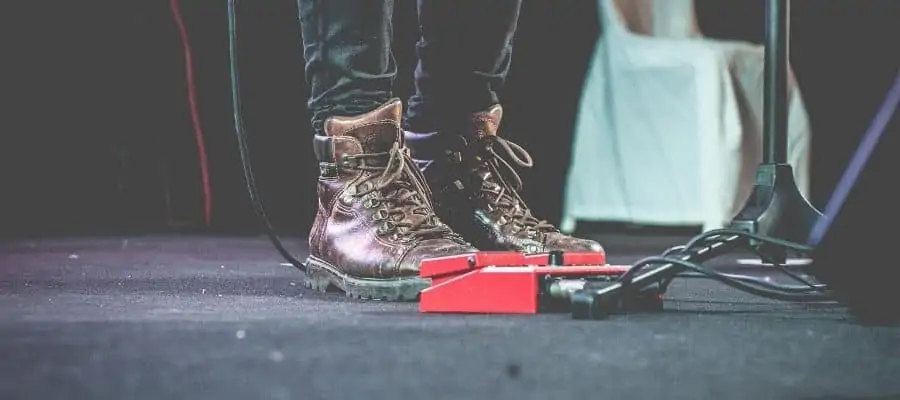
In music, an envelope shows the way how the sound changes over time. Once you pluck a string, the first stage is the attack. Attack represents the time needed for the sound to reach its peak.
After that, the decay will happen. During this stage, the sound will drop slightly from its peak to sustain level. The third stage, or sustain, is what we’re trying to increase with these pedals, and it is the length of the note you can play on your instrument. Lastly, the release is a final decay from the sustain level to silence.
Now, what happens when you chain a compressor pedal is interesting. It will “even out” the sound coming out of your guitar. This means that the pedal will soften any loud part you play on the guitar, and make any soft notes louder.
The reason why this is important is that almost every compressor pedal allows you to adjust sustain. In essence, sustain will control the amount of compression from your guitar. This is especially important for clean sound since it quickly begins to decay.
Once you play the note, as the sound starts to decay, the compressor pedal will increase the volume and even it, delivering more sustain.
How To Chain Compression/Sustain Pedals
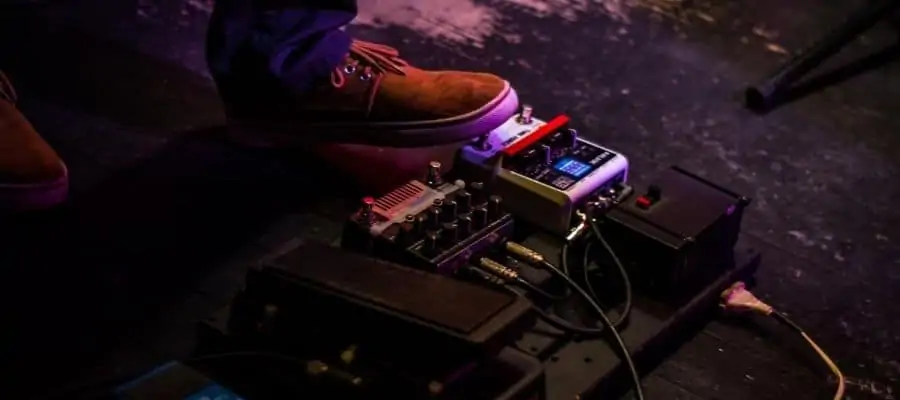
If you want to use a compressor, you will need a power supply and a couple of cables. The pedal needs one cable for the input and one for the output. Furthermore, you will need a source of power which is usually a 9V battery. If this is your only pedal, you can use batteries since they can last for quite a while.
However, if you have a pedalboard, replacing batteries can be both costly and troublesome. It might be in your interest to get a power bank or power supply which will provide voltage for the entire pedalboard. Similarly, pedalboards often use patch cables instead of regular ones, to save space and eliminate the mess that comes with too many cables on the stage.
Where To Chain Compression/Sustain Pedals
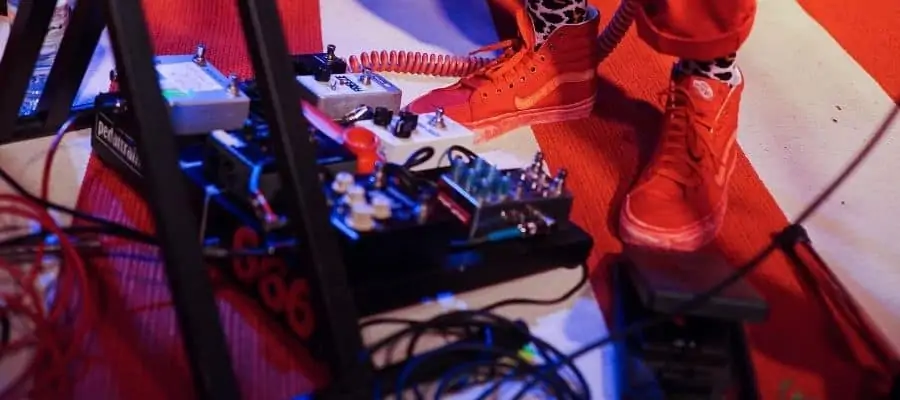
If you have a couple of pedals on your pedalboard, it is important to know the right order. Placing a certain pedal on the beginning or the end of the chain can make a world of difference, and you need to know where you should place each effect.
Furthermore, if you have more pedals, you might want to consider getting a power supply since effects don’t come with one. You don’t want to deal with dozens of batteries and wonder if each will survive the show.
Dynamic effects usually go at the beginning of the signal chain. This includes compressors, wah, pitch shifters, and volume. If you have both a wah pedal and a compressor, placing the compressor before can limit functionality.
However, the compressor can be placed both before and after the overdrive depending on the sound you want to achieve.
Gain pedals are usually on the next slot, and this includes both overdrives and distortions. Modulations like chorus, phasers, and flangers usually come next. Finally, delays and reverbs are typically at the end of the chain.
Volume pedal can go both at the beginning and the end, depending on the effect you’re trying to achieve.
How To Use Sustain/Compressor Pedal
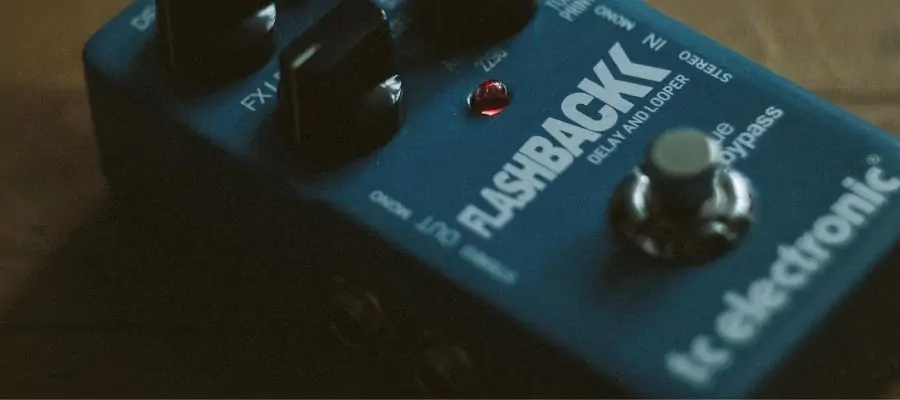
Using a compressor pedal might take you some time. It is not something that you just turn on and start playing, and you will need a bit of practice if you are inexperienced. Based on the model of the pedal you get, you will have to adjust the sound.
As you could see on the list, most pedals have three or four knobs you can use. There is an attack, sustain (or release), compression (or depth), and level.
Attack serves to show what the pedal does to your signal. If you like hearing the sound of the pick whenever you play a note, you should turn the knob up. Sustain will determine the length of the note, and depending on your wishes (and the type of pedal) you’ll be able to adjust it to your needs.
Compression is the overall amount of compression by the pedal, and level is the volume on the output.
If this sounds scary to you, you shouldn’t worry. Using a compressor is a lot simpler than using a delay pedal, and you will be able to understand it in no time.
Summary
Compressor pedals are among the most popular effects you can buy. They have been around for quite a while, and you will have a challenging time finding a guitarist without it. But a compression pedal can do one more thing and that’s to increase the sustain.
There aren’t many companies designing sustain pedals only, and they usually come as a combination of sustain with distortion, fuzz, compressor, and others.
Since there are many different “sustain” pedals available on the market, the only thing important is your music taste and budget. The price for sustain pedal can be between $25 and well over $300, so choose carefully.
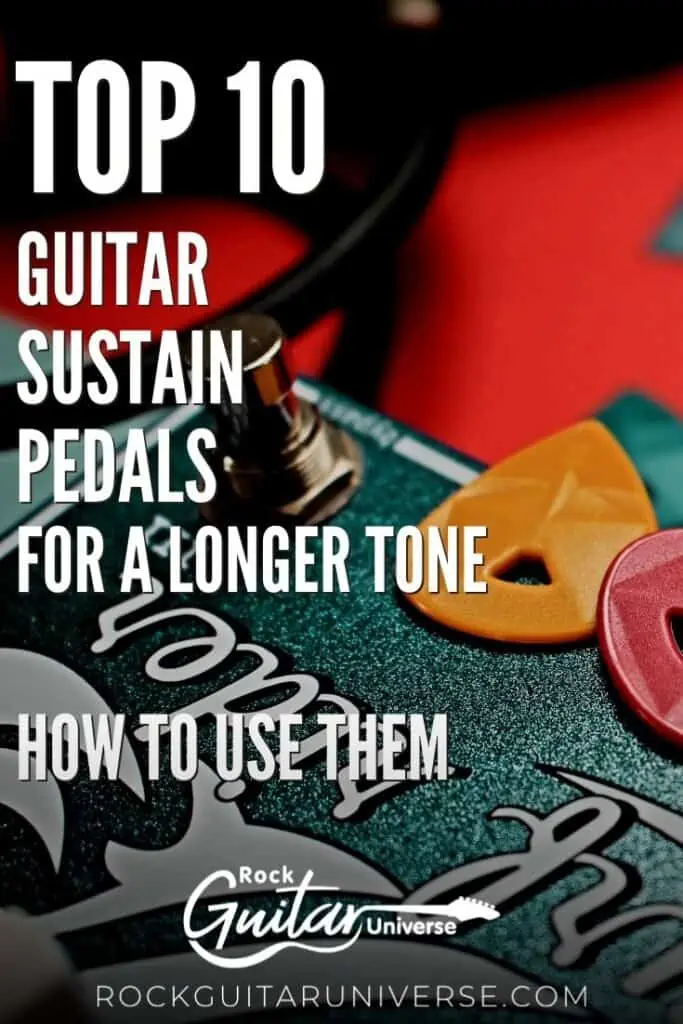
Last update on 2025-07-05 / Affiliate links / Images from Amazon Product Advertising API
Recent Posts
Some guitarists insist on buying an expensive amplifier with their electric guitar. They assume that this is a must for every type of guitarist out there. However, in some situations, this isn’t...
Top 50 Free Realistic Guitar VST Plugins With Sound Examples
As technology has rapidly advanced in the recent decade, computers are stealing more and more roles from physical musical instruments and accessories. Nowadays, you do not need expensive amps,...

